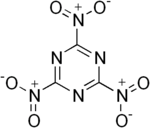Trinitrotriazine
| Trinitrotriazine | |
|---|---|
 | |
| IUPAC name 2,4,6-Trinitro-1,3,5-triazine | |
| Identifiers | |
| CAS number | 140218-59-3 |
| ChemSpider | 15188373 |
| Jmol-3D images | {{#if:O=[N+]([O-])C1=NC([N+]([O-])=O)=NC([N+]([O-])=O)=N1O=N(=O)c1nnnc(c1N(=O)=O)N(=O)=O|Image 1 Image 2 |
| |
| |
| Properties | |
| Molecular formula | C3N6O6 |
| Molar mass | 216.07 |
| Except where noted otherwise, data are given for materials in their standard state (at 25 °C (77 °F), 100 kPa) | |
| Infobox references | |
Trinitrotriazine, or 2,4,6-trinitro-1,3,5-triazine, is a theoretical explosive compound. Synthesis of this compound has been elusive despite its simple structure,[1][2] as conventional nitration of triazine becomes increasingly more difficult as more nitro groups are added. A successful route would more likely proceed by trimerisation of nitryl cyanide, but this precursor also has not yet been synthesised.[3]
It has a perfect oxygen balance, potentially making it a very powerful explosive, though calculations predict it would be fairly unstable and inferior to the related compound 3,6-dinitro-1,2,4,5-tetrazine.[4]
See also
- RDX (hexahydro-1,3,5-trinitro-1,3,5-triazine)
References
- ↑ G. D. Hartman, R. D. Hartman and J. E. Schwering. Tetrahedron Letters. 1983; 24: 1011.
- ↑ M. D. Coburn, C. L. Coon, H. H. Hayden and A. R. Mitchell. Synthesis. 1986: 490.
- ↑ Korkin AA. Bartlett RJ. Theoretical Prediction of 2,4,6-Trinitro-1,3,5-triazine (TNTA). A New, Powerful, High-Energy Density Material? Journal of the American Chemical Society. 1996; 118: 12244-12245.
- ↑ Jinshan Li. An Ab Initio Theoretical Study of 2,4,6-Trinitro-1,3,5-Triazine, 3,6-Dinitro-1,2,4,5-Tetrazine, and 2,5,8-Trinitro-Tri-s-Triazine. Propellants, Explosives, Pyrotechnics. December 2008; 33(6):443-447.